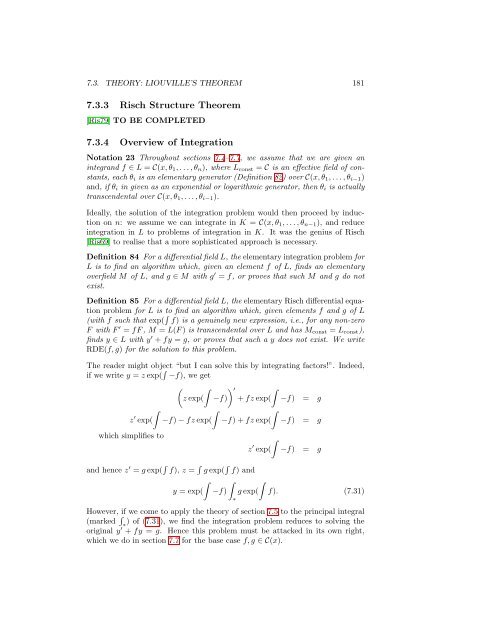Contents - Student subdomain for University of Bath
Contents - Student subdomain for University of Bath
Contents - Student subdomain for University of Bath
Create successful ePaper yourself
Turn your PDF publications into a flip-book with our unique Google optimized e-Paper software.
7.3. THEORY: LIOUVILLE’S THEOREM 181<br />
7.3.3 Risch Structure Theorem<br />
[Ris79] TO BE COMPLETED<br />
7.3.4 Overview <strong>of</strong> Integration<br />
Notation 23 Throughout sections 7.4–7.7, we assume that we are given an<br />
integrand f ∈ L = C(x, θ 1 , . . . , θ n ), where L const = C is an effective field <strong>of</strong> constants,<br />
each θ i is an elementary generator (Definition 82) over C(x, θ 1 , . . . , θ i−1 )<br />
and, if θ i in given as an exponential or logarithmic generator, then θ i is actually<br />
transcendental over C(x, θ 1 , . . . , θ i−1 ).<br />
Ideally, the solution <strong>of</strong> the integration problem would then proceed by induction<br />
on n: we assume we can integrate in K = C(x, θ 1 , . . . , θ n−1 ), and reduce<br />
integration in L to problems <strong>of</strong> integration in K. It was the genius <strong>of</strong> Risch<br />
[Ris69] to realise that a more sophisticated approach is necessary.<br />
Definition 84 For a differential field L, the elementary integration problem <strong>for</strong><br />
L is to find an algorithm which, given an element f <strong>of</strong> L, finds an elementary<br />
overfield M <strong>of</strong> L, and g ∈ M with g ′ = f, or proves that such M and g do not<br />
exist.<br />
Definition 85 For a differential field L, the elementary Risch differential equation<br />
problem <strong>for</strong> L is to find an algorithm which, given elements f and g <strong>of</strong> L<br />
(with f such that exp( ∫ f) is a genuinely new expression, i.e., <strong>for</strong> any non-zero<br />
F with F ′ = fF , M = L(F ) is transcendental over L and has M const = L const ),<br />
finds y ∈ L with y ′ + fy = g, or proves that such a y does not exist. We write<br />
RDE(f, g) <strong>for</strong> the solution to this problem.<br />
The reader might object “but I can solve this by integrating factors!”. Indeed,<br />
if we write y = z exp( ∫ −f), we get<br />
∫<br />
z ′ exp(<br />
( ∫<br />
z exp(<br />
−f) − fz exp(<br />
′ ∫<br />
−f))<br />
+ fz exp(<br />
∫<br />
∫<br />
−f) + fz exp(<br />
−f) = g<br />
−f) = g<br />
which simplifies to<br />
∫<br />
z ′ exp(<br />
−f) = g<br />
and hence z ′ = g exp( ∫ f), z = ∫ g exp( ∫ f) and<br />
∫ ∫ ∫<br />
y = exp( −f) g exp( f). (7.31)<br />
However, if we come to apply the theory <strong>of</strong> section 7.5 to the principal integral<br />
(marked ∫ ) <strong>of</strong> (7.31), we find the integration problem reduces to solving the<br />
∗<br />
original y ′ + fy = g. Hence this problem must be attacked in its own right,<br />
which we do in section 7.7 <strong>for</strong> the base case f, g ∈ C(x).<br />
∗












![[Luyben] Process Mod.. - Student subdomain for University of Bath](https://img.yumpu.com/26471077/1/171x260/luyben-process-mod-student-subdomain-for-university-of-bath.jpg?quality=85)



